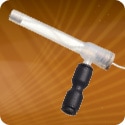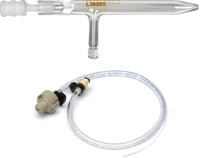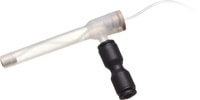Access Agilent eNewsletter, July 2013
>> Update My Profile | Subscribe to Access Agilent | Article Directory

Tips on choosing – and using – the best nebulizer for your ICP-OES
By Eric Vanclay
Agilent Product Manager, Spectroscopy
With the myriad designs and models available, selecting a nebulizer that will provide optimal performance in your application might seem to be a challenging process. This article clarifies differences in nebulizer design and performance to assist you with initial selection, and it offers guidelines for maintaining that optimal performance over time.
The function of the nebulizer is to create an aerosol with a uniformly small droplet size. Sensitivity depends upon the amount of sample reaching the plasma, and good precision (better than 1% RSD) is achieved when a nebulizer generates a steady, fine aerosol. The following criteria outline key considerations for nebulizer selection. It should:
- Accommodate your required range of sample types and solution flow rates without loss of performance
- Be compatible with all solvents, including hydrofluoric acid (HF) and organic solvents
- Be unbreakable
- Produce a fine aerosol with a small droplet size (< 10 µm) to ensure best sensitivity and precision
- Have a wide internal diameter (id) capillary to eliminate blockage when testing samples with large particles or high TDS levels
- Be able to self-aspirate, or be used with pumped sample introduction
- Eliminate memory effects

Figure 1. The conventional glass concentric nebulizer (top) produces a fine aerosol for good precision and sensitivity. The inert V-groove nebulizer (bottom) tolerates high TDS levels and HF digests better, but can compromise precision.

Figure 2. The innovative Agilent OneNeb nebulizer provides improved performance as a replacement for glass concentric nebulizers.
Because of conflicting requirements among different applications, it is unlikely that a single nebulizer design will be “ideal” for all purposes. For example, choosing a wide id capillary to reduce blockage typically means producing a larger droplet size that can degrade precision. (Compare the performance characteristics of common nebulizer styles in Table 1.)
Choose your nebulizer with care
The most common nebulizer used with ICP-OES instruments is a pneumatic-based type – the glass concentric nebulizer (Figure 1, top). Several designs (e.g. SeaSpray and Conikal) offer best performance for specific matrix types. High gas velocity at the end of the fine capillary inside each nebulizer generates a fine, reproducible aerosol, ensuring good precision and sensitivity. These nebulizers are relatively inert, although not suitable for use with HF digests, and are somewhat fragile.
The inert V-groove pneumatic nebulizer (Figure 1, bottom) (also known as a Babington type) is typically used for samples that include larger particulates or higher TDS levels, or for sampling HF digests. With this design, the sample is pumped through a relatively large orifice (typically 1 mm diameter) and flows down a V-shaped channel where it is nebulized by a stream of gas emerging from a small orifice at the base of the channel. A relatively wide-bore sample stream reduces blockage, while inert-material construction (such as PTFE), ensures wide chemical compatibility (especially with HF). Droplet size is larger, however, so precision suffers when compared to concentric nebulizer performance.
Agilent does have a nebulizer that comes closer to the ideal-the innovative Agilent OneNeb (Figure 2). It features a revolutionary design that uses Flow Blurring technology to generate a fine aerosol for improved sensitivity and reduced blockages. Its construction is virtually indestructible, with superb tolerance to dissolved solids. Agilent OneNeb is also inert, so it can handle all samples including HF digests and common organic solvents. It replaces the glass concentric nebulizer and is compatible with most conventional glass cyclonic and inert spray chambers. So no matter whether you’re using Agilent’s entry level 710 ICP-OES, the high productivity 720 ICP-OES, or a non-Agilent ICP-OES instrument, the innovative OneNeb is suitable for use. OneNeb can be ordered separately, or as part of an application kit for Agilent ICP-OES systems.
Nebulizer Type |
Aerosol Efficiency |
Achieved Precision |
Tolerance to Dissolved Solids |
HF Resistance |
Organics Compatibility |
Self Aspirates |
Ideal Sample Type |
|---|---|---|---|---|---|---|---|
OneNeb |
Excellent |
Excellent |
Good |
Excellent |
Excellent |
No |
Handles most samples |
SeaSpray concentric |
Good |
Good |
Medium |
Poor |
Good |
Yes |
Environmental, soil and food digests |
Conikal concentric |
Good |
Excellent |
Poor to medium |
Poor |
Excellent |
Yes |
Clean oil samples and organic solvents |
V-groove |
Medium |
Medium |
Excellent |
Excellent |
Medium |
No |
HF digests, fusions, high TDS or used oil samples |
Table 1. Typical nebulizer performance characteristics
Maintaining your nebulizer
Improper performance of the sample introduction system is one of the most common causes of poor precision and accuracy in ICP-OES sampling. Routine flushing of the nebulizer with clean rinse liquid – between samples, and especially after analysis – can help to reduce sample buildup. In case of a blockage, backflush the nebulizer by pumping rinse solution or gas through the nebulizer tip. Use dedicated nebulizer cleaning tools to simplify back flushing. For difficult-to-remove blockages, soak overnight in concentrated nitric acid. Never sonicate a glass concentric nebulizer, as this will damage the sample capillary.
Making the right nebulizer choice
Considering all the characteristics of your sample stream and corresponding nebulizer options in Table 1 makes it easier to select the right nebulizer(s) for your sampling application(s). The universal design of the Agilent OneNeb simplifies that process even further, as it handles most samples – including those with high TDS levels, HF digests and common organic solvents. At the same time, its consistently fine aerosol droplet size (< 10 µm) ensures sensitivity and precision with efficient operation over a wide flow rate. Discover the best nebulizer for your ICP-OES today.
>> Update My Profile | Subscribe to Access Agilent | Article Directory